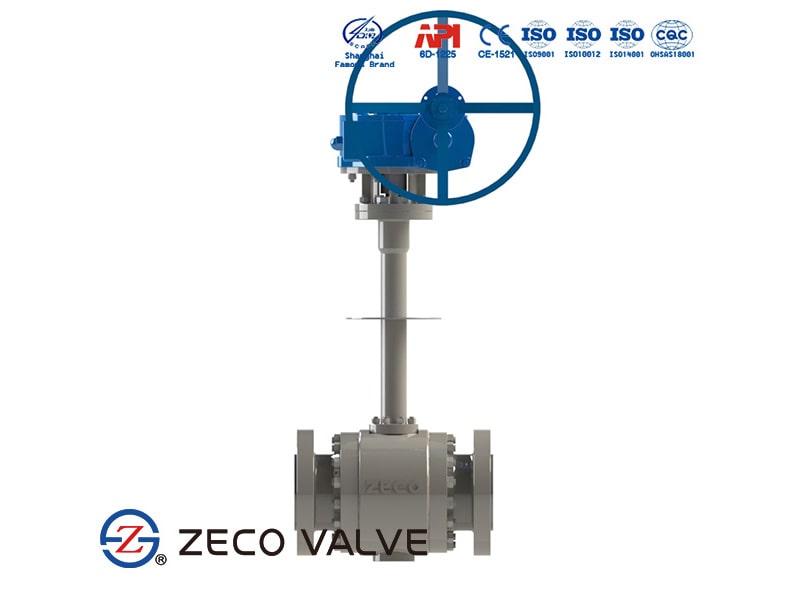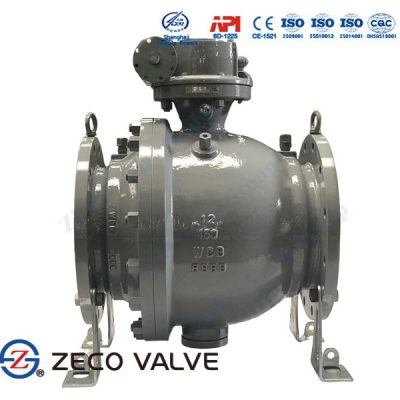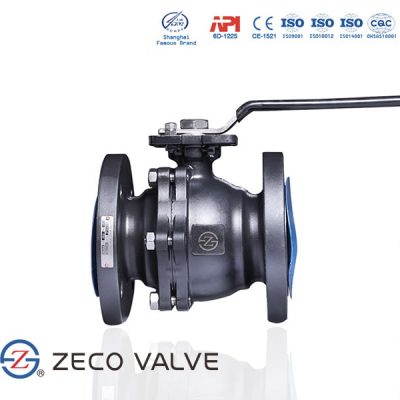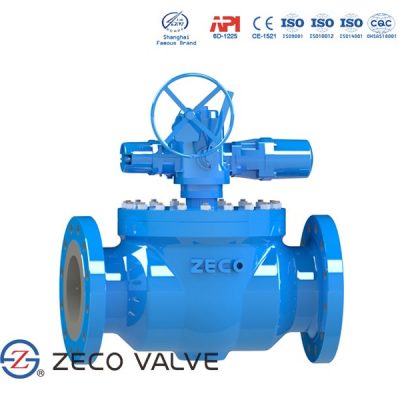Cryogenic Ball Valve
Description
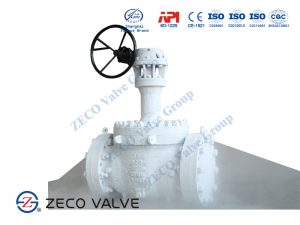
What is Cryogenic Valve?
Cryogenic valves are kept in a natural closed position to keep cryogenic gasses or other mediums secure and safely contained. A cryogenic valve is generally designed to react to high pressure which pushes the valve into the open position to allow the gas or other media to flow readily through.
What is a Cryogenic Ball Valve?
ZECO cryogenic ball valve can be designed floating ball and trunnion mounted ball type. To prevent abnormal rising pressure in the valve body cavity, on the upstream side the ball will be made a hole to connect the body cavity between the upstream pipeline and balance pressure, So at installation need to consider the medium flow direction. The valve seat structure is used DBB type, that can self-relieving pressure into the upstream or downstream pipeline when the body cavity pressure abnormal rising. Between body and seat, the seal type is designed to double Lip-seal or with reversed-load double Lip-seal. Between stem and packing is used Lip-seal + graphite type. The valve packing will be loaded in Belleville spring in order to prevent looseness. The valve bonnet is designed extended-bonnet type. To different service temperatures in order to keep packing seat temperature above 0℃.
Specifications of Cryogenic Ball Valve
- Class 150 to Class 2500
- Size Range ¼” thru 24” (Class Dependent)
- Floating and Trunnion, Full and Reduced Bore
- Body Wall Thickness ASME B16.34, Forged or Cast Versions
- Cryogenic tested to -196°C (-320°F)
- Fire-Safe Design API 607
- Vented Ball Standard
- Blowout Proof, Low Torque Guided Stem Design
- Live-Loaded Packing and Anti-Static Capable
- Fugitive Emissions ISO 15848
- PTFE, TFM, CTFM, PCTFE, and Metal Seats Available
- Valves are degreased, cleaned, and packaged prior to shipping
- Custom Face-to-Face Lengths Available per Customer Requirement
- Manual, Electric, Pneumatic, or Electro-Hydraulic Operators Available
- Fire Testing: API 607, API 6FA, BS 6755 Part II
- Testing: API 598, API 17D, ISO 5208, BS 6755 Part I, BS 6364
- Marking: MSS-SP-25, PED
- Certifications: API607, SIL, NACE, MR0175, PED, Fugitive Emissions
Why Cryogenic Valve has an Extended Bonnet?
Ethylene, liquid oxygen, liquid hydrogen, liquefied natural gas, liquefied petroleum, and other liquid media the cryogenic valve transfers are flammable and explosive. What is more, they are going to gasify and expand hundreds of times when the temperature rises.
This kind of valve is always equipped with an extended bonnet or namely extended stem. That’s because:
- The extended bonnet can prevent the stuffing box, which plays an important role in the cryogenic valve and other valves, from damaged by low temperature. As the temperature goes down, the packing will gradually become less elastic and lost its ability to prevent leakage. Then, medium freeze in the space between the packing and the stem, hampering the movement of the stem and scratching the packing as the stem moves. In the end, what follows is severe leakage. Therefore, an extended stem is used to ensure that the packing is warm enough, at least above 8℃.
- The extended structure of the bonnet makes it convenient to wrap special materials around the valve, preventing the loss of cold energy.
- The pipes and valves are often installed in the so-called ‘cold box’, but its ‘long neck’ can go through the wall of the ‘cold box. Based on that, the extended stem makes it convenient to dismantle or replace the main parts of the valve quickly through the bonnet.
Hence, the valve body and the pipeline are welded together to reduce the leakage of the cold box as much as possible and ensure the sealing performance of the valve.
Features of Cryogenic Ball Valve
- ZECO cryogenic ball valve pressure parts because after cryogenic treatment before machining, in liquid nitrogen tank – 196 ℃ repeat twice last insulation 1 ~ 2 hours, so ZECO ball valve parts won’t because of the change of the medium temperature caused by heat bilges cold shrink, sealing structure will not cause deformation because of the low temperature;
- In order to protect the long-term sealing effect of the packing box, the cover of the ZECO cryogenic ball valve adopts the long-neck structure to keep the packing box away from low temperature and add insulation material to it;
- The specially developed gasket of ZECO cryogenic ball valve can ensure the normal operation at low temperature and normal temperature;
- The stem of ZECO cryogenic ball valve is also chrome plated and nitride treated, greatly improving the surface hardness of the stem.
- Ball / Seat Lapping
- Lapped ball and seat sets are utilized when materials and sealing requirements dictate. This precise manufacturing process ensures the lowest operating torque and the tightest possible sealing capability of the ball and seats, while at the same time providing for an exceptionally long service life for the intended application. Lapping is a surface finishing process where extremely fine polishing compounds are used as the lapping agent to achieve remarkably close mating surfaces.
- Energy Saving Stem Extension
- The clearance between the ID of the stem extension housing and the OD of the forged stem is designed to be less than 1mm. This configuration is designed to keep heat away from the liquid contained in the line, thereby saving significant energy costs.
- Cryogenic Testing
- ZECO Valve designs cryogenic service ball valves in full compliance with BS 6364 which includes proof of design testing at severe low temperatures of -196℃. Detailed quality inspections are performed before and after cryo testing, and valves are re-assembled and tested again at ambient temperatures for verification.
Material of Cryogenic Ball Valve
| No | Part | Material |
| 1 | Body | ASTM A350 LF2 |
| 2 | Bonnet | ASTM A350 LF2 |
| 3 | Ball | ASTM A350 LF2 |
| 4 | Seat | ASTM A182 F316 + TFM |
| 5 | Stem | 17-4PH |
| 6 | Anti-static Device | SS316 |
| 7 | Gasket | Graphite + SS316 |
| 8 | Bolt | ASTM A193 B8 |
| 9 | Nut | ASTM A194 8 |
| 10 | O-ring | Viton A |
| 11 | Lever | ASTM A216 WCB |

